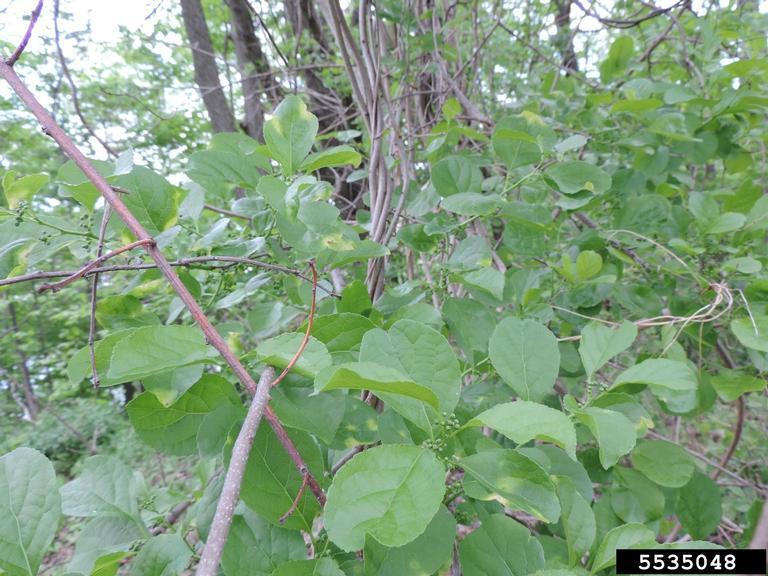Like many invasive plants in North American woodlands, Oriental bittersweet is a strong competitor for light and nutrients in a variety of disturbed landscapes. It can be found along roadsides, in fallow fields, and in woodlands that have been recently harvested. Also called Asian bittersweet, climbing spindle berry, and round-leaved bittersweet, it grows as a vine that has significant impacts on plants and trees in the landscape.
What is it?
Oriental bittersweet (Celastrus orbiculatus Thunb.) is a native of Korea, China and Japan, and was introduced in the United States around 1860. It was planted for both erosion control and ornamental purposes, but spread into the environment in the succeeding decades. It was first reported wild in Connecticut in 1916; by 1938, it had spread to New Hampshire. Since then, its range has expanded widely and is still a popular ornamental vine. Today, it is reported as far north as Québec, as far south as Louisiana, and as far west as Kansas. In Maryland, it is reported in all counties except Garrett. See the distribution map below.

It is a deciduous, climbing, woody vine that can grow up to 60 feet in length and up to four inches in diameter. As it grows in spirals around a tree, the vine is able to girdle and kill the tree or break off its branches under its weight. If it reaches the tree canopy, it can shade out native species.
How does it spread?
Oriental bittersweet has both male (non-fruit-bearing) and female (fruit-bearing) plants. Pollination can occur through bees and other insects. Birds and other wildlife consume the large number of berries the vine produces and spread the seeds far and wide. The seeds can survive in the soil for up to two years without germination. Humans also spread the seeds by using the vines for decorations and for craft projects. Additionally, the plant spreads vegetatively through suckers and rhizomes.
How can I identify it?
This invasive has alternate, elliptical leaves that are light green in color, finely-toothed and two to five inches in length. Oriental bittersweet’s fruits are round and yellow which split to reveal bright red berries through the fall and winter months.
This invasive vine can be distinguished from the native American bittersweet by the placement of the flowers and fruits. American bittersweet has flowers and fruits at the ends of its branches. Oriental bittersweet’s flowers and fruits are located in the angle between the leaf shoot and the leaf itself. See the Image Gallery below.
How can I control it?
Once established, Oriental bittersweet is difficult to control. It will be a long-term process. There are three methods of control: manual, mechanical, and chemical. Usually a combination of all three is most effective.
Manual removal is best when an infestation is detected early. Hand-pulling must remove the vine and all roots, to be bagged and disposed of in the trash. The area must be observed for several years to ensure re-sprouting does not occur. Continued mowing or heavy grazing by goats can also be effective.
Mechanical and chemical methods are often effective when used in combination. Brush hogs or similar equipment can be used to pull up thick infestations. Individual vines can be cut at ground level; foliar herbicide treatments can then be applied directly to the rooted section. Basal application and stem injection methods can also be effective. These are preferred when there are desirable species present in the area. Foliar application is common in large areas when no other desirable species exist.
For more information:
Learn more about Oriental bittersweet:
Forest Pests: Invasive Plants and Insects of Maryland (Maryland DNR Forest Service)
Invasive Plants in Pennsylvania: Oriental Bittersweet (Pennsylvania Dept. of Conservation & Natural Resources)
Oriental bittersweet (invasive.org)
